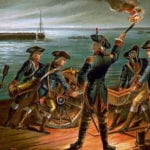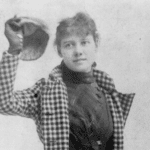 Technology
Technology  Technology
Technology  Humans
Humans 10 Everyday Human Behaviors That Are Actually Survival Instincts
 Animals
Animals 10 Animals That Humiliated and Harmed Historical Leaders
 History
History 10 Most Influential Protests in Modern History
 Creepy
Creepy 10 More Representations of Death from Myth, Legend, and Folktale
 Technology
Technology 10 Scientific Breakthroughs of 2025 That’ll Change Everything
 Our World
Our World 10 Ways Icelandic Culture Makes Other Countries Look Boring
 Misconceptions
Misconceptions 10 Common Misconceptions About the Victorian Era
 Mysteries
Mysteries 10 Strange Unexplained Mysteries of 2025
 Miscellaneous
Miscellaneous 10 of History’s Most Bell-Ringing Finishing Moves
 Technology
Technology Top 10 Everyday Tech Buzzwords That Hide a Darker Past
 Humans
Humans 10 Everyday Human Behaviors That Are Actually Survival Instincts
 Animals
Animals 10 Animals That Humiliated and Harmed Historical Leaders
Who's Behind Listverse?

Jamie Frater
Head Editor
Jamie founded Listverse due to an insatiable desire to share fascinating, obscure, and bizarre facts. He has been a guest speaker on numerous national radio and television stations and is a five time published author.
More About Us History
History 10 Most Influential Protests in Modern History
 Creepy
Creepy 10 More Representations of Death from Myth, Legend, and Folktale
 Technology
Technology 10 Scientific Breakthroughs of 2025 That’ll Change Everything
 Our World
Our World 10 Ways Icelandic Culture Makes Other Countries Look Boring
 Misconceptions
Misconceptions 10 Common Misconceptions About the Victorian Era
 Mysteries
Mysteries 10 Strange Unexplained Mysteries of 2025
 Miscellaneous
Miscellaneous 10 of History’s Most Bell-Ringing Finishing Moves
10 Historical Events That Never Happened
Fact or fiction? Who knows?
Now you do. History isn’t an exact science, and humans are only, well, human. We make mistakes and tend to exaggerate or even lie, and sometimes, these white lies or tweaks to the truth can have huge consequences, like leading to millions of people worshiping someone for something that never happened. Or hating someone for something that never happened.
Here are ten historical events that never actually happened in the way we believe.
Related: 10 Tragedies Blamed On Mythical and Fictional Creatures
10 William Tell Never Shot an Arrow at an Apple on His Son’s Head
In Switzerland, children grow up learning about William Tell, the heroic man who defied the invading Hapsburgs by refusing to uncover his head before passing by a Hapsburg hat. As punishment for his crime, the farmer was forced to shoot an apple off of his son’s head under threat of death for both of them.
Tell was successful and allegedly inspired the Swiss people to rebel against the Austrian monarchy and create their own independent country. It has come to historians’ attention that there is no evidence Tell ever existed, and he was probably a fictional folk hero, not a historical figure. Switzerland, however, won’t hear it. Tell is still treated as a national hero and image of Swiss independence, and his existence isn’t to be trifled with.[1]
9 Thomas Edison Never Invented the Lightbulb
Inventors, particularly those throughout the late 1800s, were constantly fighting for credit. As one person created a new technology, no sooner would it premiere than another man had improved upon it and called it his own idea.
That’s pretty much the story of the lightbulb. We all associate the gas bulb with Thomas Edison; however, British chemist Humphry Davy is actually credited with making the first iteration of the invention back in 1802. Dozens of men after him tinkered with the new innovation, and the bulb evolved throughout the 1800s. Edison wasn’t even officially the first one to create the modern incandescent bulb; over 20 other men have claimed that title. Edison was just the first of them to make it commercially successful enough to actually matter.
That’s business.[2]
8 Paul Revere Never Shouted: “The British Are Coming!”
Paul Revere is hailed as an American hero. Allegedly, during the American Revolution, Revere received word that the British were planning to raid the nearby town of Concord. He sped through the night yelling, “The British are coming!” as a warning to all citizens to be on alert, hide their valuables, and get ready to fight.
But not really. Revere’s midnight ride did happen, but it was a quiet and secret operation. Only select people were warned, mostly patriots who needed to hide their weapons and high-ranking American rebels like John Hancock and Samuel Adams. Revere definitely wouldn’t have yelled, as British soldiers were stationed all over the countryside and could have been intercepted at any moment. And he wasn’t the only rider that night, just the only one to have a poem written about him by American icon Henry Wadsworth Longfellow. “Paul Revere’s Ride,” published in 1860, solidified Revere’s place in history, false facts and all.[3]
7 Christopher Columbus Didn’t Prove the World Was Round
Triumphant and tired, Christopher Columbus comes marching back to Spain to report his groundbreaking geographic finding. “The earth is round, and I have proved it!” he exclaims. “Yeah, we know,” says Queen Isabella.
Maybe it didn’t happen exactly like that, but the fact stands: In 1492, most people in Europe already knew the earth wasn’t flat. As early as 600 BC, it was common knowledge that the earth was a globe, and according to historian Jeffrey Burton Russel, “No educated person in Western Civilization from the third century BC onward believed that the earth was flat.”
The idea that Columbus was a pioneer of science for his discovery came from Washington Irving, author of such classic stories as “Rip Van Winkle” and “The Legend of Sleepy Hollow.” While visiting Spain in 1828, Irving was inspired to write a biography of Columbus. Unfortunately, the biography took a lot of creative liberties, including claiming that Spanish geographers didn’t believe Columbus’ claims that the earth was round (which never happened).
Sorry, folks.[4]
6 Betsy Ross Never Created the First American Flag
Sorry to ruin the image of a kindly old woman sitting by the fire, bravely yet stoically sewing on each individual star to the newly created American flag. It didn’t happen like that.
Elizabeth Ross was a famous flag maker during the Revolutionary War. Legend has it that in 1777, George Washington himself commissioned Ross to create the first flag of the new country. He even took some design suggestions from her (the six-point stars are believed to have been Ross’s doing). The story originally comes from William Canby, Ross’s grandson, who, in 1870, told the narrative at the Pennsylvania Historical Society.
There is no evidence that a new flag was created during this time, and although Ross was an important seamstress and flag maker for the U.S. government throughout the 1700s, the Smithsonian declares that Ross probably never actually created the first U.S. flag.[5]
5 No One Committed Suicide on Wall Street in 1929
The image of businessmen leaping to their deaths after the Stock Market Crash of 1929 has haunted Americans for almost a century. Black Thursday saw 12.9 million shares traded on Wall Street, effectively ruining the economy. In their despair, dozens of stock brokers tried to escape their problems by jumping off the top of Manhattan skyscrapers.
Except they didn’t. As early as the next day, the New York Daily News reported that “If half the suicides which were reported yesterday had proved true, Wall Street would be a deserted village.” In fact, the number of suicides in the United States was actually lower in October of that year, when the crash happened, and much higher in the summer months before it. A few weeks later, rumors still swirled, and New York City’s chief medical examiner was forced to publicly explain that the suicide rates at the time were actually lower than usual.
Dark humor and dramatics helped the American people cope with disaster and continued the stories, despite the fact that there wasn’t a single reported case of anyone killing themselves on Wall Street in 1929.[6]
4 War of the Worlds Never Caused Mass Panic
One of history’s greatest examples of the power of fiction might not have been as impactful as you believe.
In 1938, Orson Welles and a group of actors interrupted a radio news broadcast to report that aliens were invading America. It was part of an audio adaption of H.G. Welles’s fictional novel War of the Worlds told through a series of news bulletins. For years, it was believed that thousands of listeners across the country thought the broadcast was real and panicked, with stories of people running into shops shouting the news and jumping out of their cars spreading quickly.
Recent research has proved that less than 2% of people listening to the radio at that time were listening to the broadcast, and there was no evidence of anyone believing it was real. It turns out that newspapers, scared about the sudden rise of radio, seized the opportunity to point out that radios couldn’t be trusted and tried to exploit the situation. Sure, some people may have thought the earth was really being invaded by Martians, but there’s little firsthand evidence of this supposed hysteria.[7]
3 No Witches Were Burned During the Salem Witch Trials
Despite what Monty Python and the Holy Grail may have led you to think, there were no angry mobs burning women during the Salem Witch Trials in Massachusetts. But things still weren’t great.
Between June and September 1692, 152 people were charged with the crime of witchcraft in the small town of Salem, Massachusetts. Contrary to popular belief, not all of the accused were women; men were also thrown in jail for these false accusations. Out of these 152 prisoners, only 19 actually ended up being put to death, and none of them were burned at the stake.
We associate witches with burning because, in medieval times, it was a popular way to kill witches for their crimes, but only in Europe. Once the American Colonies were settled, it was decided that witchcraft would be handled as a felony, a crime against the government, rather than as heresy, a crime against the church. Thirteen victims of the Salem Witch Trials were hanged and not burned, and the other four died due to the conditions in prison.
What happened to that last victim, you ask? That was Giles Corey, an elderly man who refused to plead and thus could not be tried. To get around this, the Salem government forced Corey to lie down with heavy boards on top of his body. Rocks and other heavy objects were added until the sufferer finally succumbed. In his final act of defiance, it is reported that Corey’s last words were “more weight!”[8]
2 Nero Never Fiddled as Rome Burned
If you know any Roman emperors besides Julius Caesar, it’s probably the infamous Nero. Though we don’t know much about the man because he died over 2,000 years ago, plenty of stories followed him throughout history. From killing his mother and two of his wives to persecuting Christians, it’s safe to say that Nero has not been remembered as fondly as his great-great-great-great-great-uncle, Julius, or even his great-great-grandfather Augustus.
One of the most memorable images of Nero as a leader comes from the Great Fire of Rome in AD 64 when it’s alleged that the emperor happily strummed his fiddle and danced away from the flames. This legend came about from none other than William Shakespeare, who wrote (facetiously) that Nero played the lute while the city burned. Somewhere in translation, a lute was changed to a fiddle, and the legend has become almost fact.
Almost. While it’s not out of the scope of possibility for Nero to have been celebrating the destruction of the city, as Encyclopedia Brittanic puts it, “More likely he strummed a proto-guitar while dreaming of the new city he hoped would arise as in the fire’s ashes.” This might not be literally true, but the phrase “fiddling while Rome burns” has come to be a metaphor for Nero’s reign, which was full of suffering at his hand.[9]
1 Marie Antoinette Never Said, “Let Them Eat Cake!”
It’s been mocked in media for literally centuries, but is it true? Probably not.
Legend has it that when faced with the news that French peasants were starving, the queen of France, Marie Antoinette, said goofily, “Let them eat cake!” The quote has haunted Antoinette’s legacy for years, making her appear to be a daft and uninvolved ruler during the French Revolution.
Recent evidence, however, has shown that the phrase is actually the English translation of “Qu’ils mangent de la brioche,” which means “Let them eat brioche.” So even if the story is true, she would have effectively been saying they could eat fancy bread, not cake. But even that is unlikely to have actually happened, as the phrase goes back to a writer in 1765 who tells the exact same story of a princess out of touch with reality. But Marie Antoinette was only nine years old at the time.
Most modern historians agree the story was simply a way to villainize royalty during the French Revolution, especially because Antoinette was known for her charity and generosity to the poor.[10]








